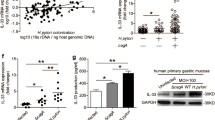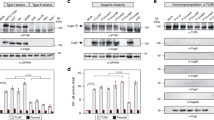Abstract
Introduction
Enterocromaffin-like cells (ECL) are specialized endocrine gastric cells able to release histamine, which in turn controls gastric acid production by parietal cells. Helicobacter pylori infection and other conditions signal in the gastrointestinal tract via Toll-like receptors (TLRs) and modify gastric acid production, but there is no evidence of expression and function of TLRs in ECL cells. In this work, we analyzed gene and protein expression of TLR-2, 4, 5, and 9, and other molecules involved in TLR signaling in ECL cells.
Material and Methods
ECL cells were isolated from Sprague–Dawley rats. The histamine-releasing ability of TLR ligands was also evaluated after culture of the ECL cells for a short time.
Results
With ECL cells that expressed the TLR-2, TLR-4, TLR-5, and TLR-9 genes we were able to confirm protein expression for TLR-2, TLR-5, and TLR-9. Functionally, ECL cells were able to release histamine in response to TLR-2 stimulation by peptidoglycan (PGN), a TLR-2 ligand. After PGN stimulus, IRAK and p38 phosphorylation could be observed. SB 203580, a p38 inhibitor, reversed PGN-induced histamine release. Lipopolysaccharide (LPS), a TLR-4 ligand, was also able to induce histamine release in ECL cells, but by a mechanism independent of TLRs.
Conclusions
We have demonstrated for the first time that ECL cells express TLRs and respond to TLR-2 ligand by increasing histamine release. This response could be involved in host defense against gastrointestinal bacterial pathogens but could also contribute to control of gastric acid secretion in the absence of pathogens.




Similar content being viewed by others
References
Håkanson R, Chen D, Andersson K, et al. The biology and physiology of the ECL cell. Yale J Biol Med. 1994;67:123–134.
Zhao CM, Håkanson R, Chen D. Secretory organelles in ECL cells: effects of pharmacological blockade of the gastrin/CCK2 receptor versus its elimination by gene targeting. Inflammopharmacology. 2005;13:75–82.
Franceschi M, Di Mario F, Leandro G, Maggi S, Pilotto A. Acid-related disorders in the elderly. Best Pract Res Clin Gastroenterol. 2009;23:839–848.
Ding SZ, Torok AM, Smith MF Jr, Goldberg JB. Toll-like receptor 2-mediated gene expression in epithelial cells during Helicobacter pylori infection. Helicobacter. 2005;10:193–204.
Kato S, Ito Y, Nishio H, Aoi Y, Amagase K, Takeuchi K. Increased susceptibility of small intestine to NSAID-provoked ulceration in rats with adjuvant-induced arthritis: involvement of enhanced expression of TLR4. Life Sci. 2007;81:1309–1316.
Lavelle EC, Murphy C, O’Neill LA, Creagh EM. The role of TLRs, NLRs, and RLRs in mucosal innate immunity and homeostasis. Mucosal Immunol. 2010;3:17–28.
Poulain-Godefroy O, Le Bacquer O, Plancq P, et al. Inflammatory role of Toll-like receptors in human and murine adipose tissue. Mediators Inflamm. 2010, 823486.
Yu L, Wang L, Chen S. Endogenous Toll-like receptor ligands and their biological significance. J Cell Mol Med. 2010;14:2592–2603.
Fitzgerald KA, Palsson-McDermott EM, Bowie AG, et al. Mal (MyD88-adapter-like) is required for Toll-like receptor-4 signal transduction. Nature. 2001;413:78–83.
Banerjee A, Gerondakis S. Coordinating TLR-activated signaling pathways in cells of the immune system. Immunol Cell Biol. 2007;85:420–424.
Prinz C, Zanner R, Gratzl M. Physiology of gastric enterochromaffin-like cells. Annu Rev Physiol. 2003;65:371–382.
Lindström E, Lerner UH, Håkanson R. Isolated rat stomach ECL cells generate prostaglandin E(2) in response to interleukin-1 beta, tumor necrosis factor-alpha and bradykinin. Eur J Pharmacol. 2001;416:255–263.
Livak KJ, Schmittgen TD. Analysis of relative gene expression data using real-time quantitative PCR and the 2(-Delta Delta C(T)) Method. Methods. 2001;25:402–408.
Gambero A, Thomazzi SM, Cintra AC, Landucci EC, De Nucci G, Antunes E. Signalling pathways regulating human neutrophil migration induced by secretory phospholipases A2. Toxicon. 2004;44:473–481.
Lowry OH, Rosebrough NJ, Farr AL, Randall RJ. Protein measurement with the Folin phenol reagent. J Biol Chem. 1951;193:265–275.
Kumar H, Kawai T, Akira S. Toll-like receptors and innate immunity. Biochem Biophys Res Commun. 2009;388:621–625.
Buchholz BM, Bauer AJ. Membrane TLR signaling mechanisms in the gastrointestinal tract during sepsis. Neurogastroenterol Motil. 2010;22:232–245.
Shaykhiev R, Behr J, Bals R. Microbial patterns signaling via Toll-like receptors 2 and 5 contribute to epithelial repair, growth and survival. PLoS One. 2008;3:e1393.
Lambrecht NW, Yakubov I, Zer C, Sachs G. Transcriptomes of purified gastric ECL and parietal cells: identification of a novel pathway regulating acid secretion. Physiol Genomics. 2006;25:153–165.
Kidd M, Miu K, Tang LH, et al. Helicobacter pylori lipopolysaccharide stimulates histamine release and DNA synthesis in rat enterochromaffin-like cells. Gastroenterology. 1997;113:1110–1117.
Kidd M, Tang LH, Schmid S, Lauffer J, Louw JA, Modlin IM. Helicobacter pylori lipopolysaccharide alters ECL cell DNA synthesis via a CD14 receptor and polyamine pathway in mastomys. Digestion. 2000;62:217–224.
Gibbs BF, Plath KE, Wolff HH, Grabbe J. Regulation of mediator secretion in human basophils by p38 mitogen-activated protein kinase: phosphorylation is sensitive to the effects of phosphatidylinositol 3-kinase inhibitors and calcium mobilization. J Leukoc Biol. 2002;72:391–400.
Boneca IG. The role of peptidoglycan in pathogenesis. Curr Opin Microbiol. 2005;8:46–53.
Viala J, Chaput C, Boneca IG, et al. Nod1 responds to peptidoglycan delivered by the Helicobacter pylori cag pathogenicity island. Nat Immunol. 2004;5:1166–1174.
Singh JC, Cruickshank SM, Newton DJ, et al. Toll-like receptor-mediated responses of primary intestinal epithelial cells during the development of colitis. Am J Physiol Gastrointest Liver Physiol. 2005;288:G514–G524.
Acknowledgments
This research Project is supported by Fundação de Amparo à Pesquisa do Estado de São Paulo (FAPESP).
Conflict of interest
The authors declare that they have no conflict of interest.
Author information
Authors and Affiliations
Corresponding author
Rights and permissions
About this article
Cite this article
Stefani, C.B., de Oliveira, R.M., Silveira, A.A.A. et al. Expression of Toll-Like Receptors in Enterocromaffin-Like Cells and Their Function in Histamine Release. Dig Dis Sci 57, 2270–2277 (2012). https://doi.org/10.1007/s10620-012-2176-6
Received:
Accepted:
Published:
Issue Date:
DOI: https://doi.org/10.1007/s10620-012-2176-6




